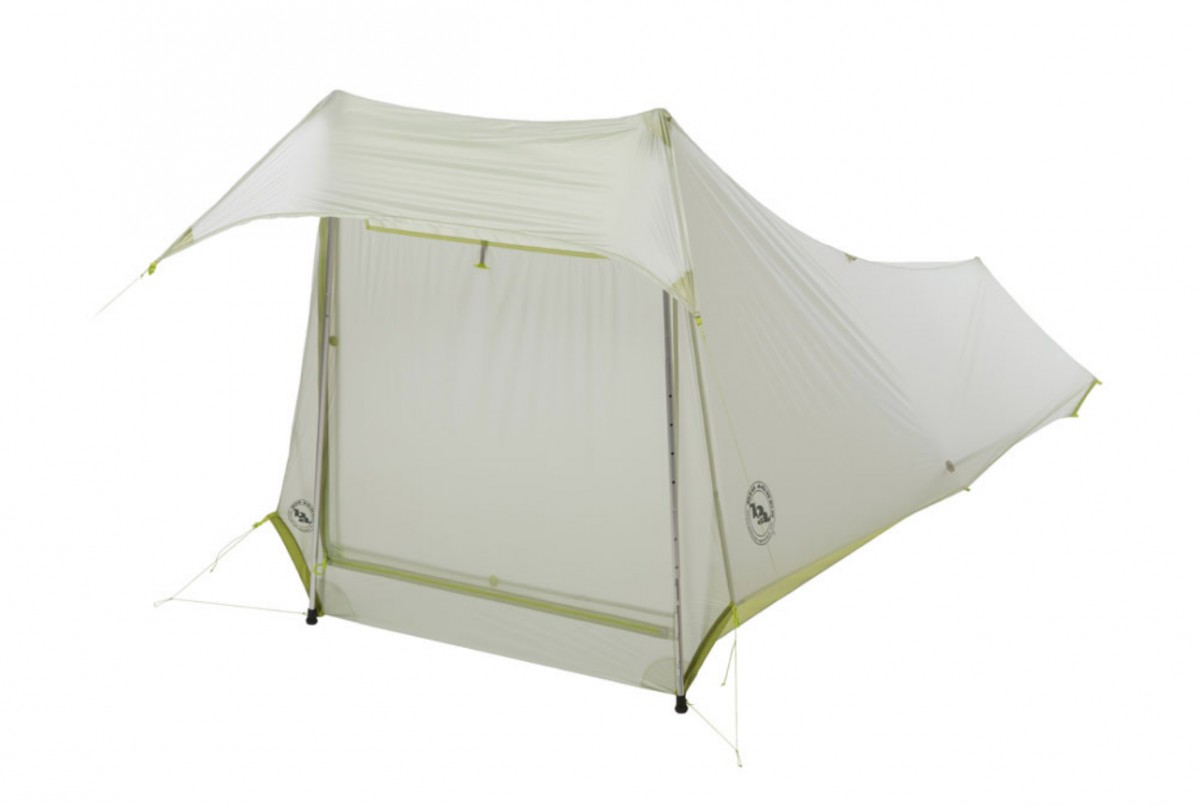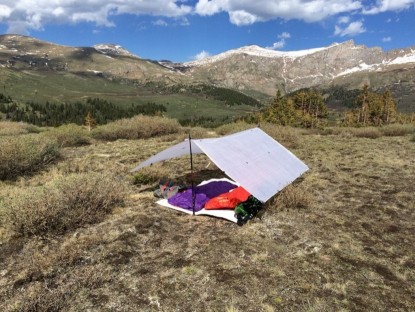Big Agnes Scout 1 Platinum Review
Our Verdict
Our Analysis and Test Results
The Big Agnes Scout 1 Platinum stands out for its superior ultralight construction, weighing in at a meager 1.1 pounds, with all included components. While it's one of the lightest shelters in this review, it sacrifices comfort and convenience; this is less of a tent and more like a super spacious bivy sack. Those that want an emergency shelter that they can weather out a storm inside of will appreciate it. Just make sure to take it where high winds and snow won't be present.
Livability
This super lightweight, bare-bones tent offers just enough liveable space to stash your gear and perhaps ride out a storm. The design is long and cylindrical, similar to a bivy sack. There's no real room inside to sit up with a pad underneath you (especially if you're tall), so you are left to lying down or propping yourself up with your elbow. Entering and exiting the tent requires you to shimmy on your belly or on your knees through the small opening.
This tent has no vestibules, so all gear must be stored in the tent with you. If you're stuck in the rain and need to use your stove, you're going to have to set a tarp up over the tent or cook elsewhere. While the small covering on top provides decent drainage in wet weather, it's not long enough to provide cooking coverage.
The length of the tent is about seven feet long, which will accommodate taller hikers and explorers. However, if you're carrying a heavier or bulkier load, be prepared for that length to decrease significantly when you stuff your bag at your feet or under your head to use as a pillow. The headroom is pretty nice at the very opening of the tent, but for taller hikers, it won't allow you to sit up fully. While Big Agnes claims this tent to be “…a roomy trail phenom”, we would beg to differ.
We slept out in this tent multiple times and found the pockets inside to be hardly useable. While there are plenty of attachments to add organizational features, this adds weight and more money that you'll need to pour into this purchase.
Also, because of its single-wall design, despite all the “ventilation”, the interior easily builds condensation. Because the tent is so narrow, it's next to impossible to avoid getting your bag wet, especially if you have to set up on a slope.
All in all, this tent is best for those that want a little more luxury and space than a bivy sack, but don't need the conveniences of a full tent. It's not very liveable but will do in a pinch if you prefer to cowboy camp and want an emergency shelter in case the rain starts to pour.
Weight
One of the reasons we chose this tent to test is its super-low weight. Similar to other solo shelters, it's ridiculously lightweight. On our scales, it comes in at only 1.1 pounds (for all components including stuff sacks), making it one ultralight — even for the ultralight category. That doesn't include the weight of your poles.
The packed size is quite small. The best stuff sack to use is the one it comes with. The base of this tent has two fixed poles built into its construction. So unlike other tents that are all fabric (no poles), that'll work with compression sacks, this one won't.
We used it on fastpacking and backpacking missions, easily fitting it amongst our ultralight gear before embarking on a small running exploration in the mountains. It fit snugly into our 30L pack and hardly felt like it was there when running with it.
Weather Resistance
We used and watched this tent's performance in wind, rain, and snow. The long and short? It's not our favorite for any type of “real weather”. The long cylindrical design needs to be placed strategically with the smaller end of the tent facing the wind, so the wind won't catch and throw the side walls around. It lacks tie-out points throughout the body, so the walls flaps and bow in high winds.
The exterior material of the tent is constructed from 200-mm SilNylon. Our water tests showed it is indeed waterproof. However, after some time, the water collected on the top and pooled in some areas, without excellent drainage. The material eventually saturates, stretches, and losses its shape over time. If there were more tensioners throughout the design, it'd be easy to readjust, but readjusting required re-staking the tent, which is annoying, especially when it's wet and cold outside.
In snow, this tent is not ideal. The flatter design on top captures the snow, collecting, and eventually collapsing it. So, our testing indicated it's best for three-season use and not the most weather protective option out there. Though it'll keep you dry in most storms, it won't be exceptionally comfortable.
Adaptability
This tent is best for those that prefer to hike with poles and typically camp in areas that stakes can get into the ground. The guy lines that come with the tent are really only adjustable in a few places, which makes this option a little less adaptable than a tarp or other shelters out there. The fixed-length guy lines force a certain distance between stakes and the tents. If the ground can't accommodate, you won't be able to pitch this tent; we recommend carrying additional cordage to avoid this problem.
We tested it in sandy and loamy environments where stakes when easily into the ground. In these cases, it was great! The cylindrical fully enclosed design requires a spot that is consistent and flat; otherwise, you'll find yourself rolled up against the side of the tent — so choose your places thoughtfully.
For rock slabs or bouldery ground, you can make it work, you but you'll be required to bring lots of extra cordages to extend the provided guy lines. The design requires a close tether to the ground in both the front and back, so attaching it to larger rocks here won't work. We wouldn't recommend buying this tent if you know you'll be traveling through rocky and slabby environments — unless you're dedicated to extra set up time. If you stick to areas that stakes go easily into the ground, you'll find confidence in its set-up, and it'll be easy. Speaking of which…
Ease of Set-Up
Set-up requires the use of trekking poles, so it's best for those that like poles. This tent is pretty simple to figure out for any seasoned tent pitcher. Simply stake out all the corners of the tent, then insert the handles of your poles to the front of the tent.
Be sure your poles are at least 105 cm long, which will ensure a roomy pitch. Once those are inserted, use the guy lines to provide tension to the front of the tent. There are some tensioners for a more precise fit, with a few extra points to attach additional guy lines. The tent comes with nine stakes — all that is used to provide a good, tensioned set-up. After a few tries, we were able to consistently set this tent up in under three minutes.
Value
If you're seeking a super crazy-light solo tent for ultralight trips, this tent has a place. The price tag isn't high for the ultralight tent world, but it's not a tent for everybody. The materials are quite thin and can rip easily if you expose the material to snaggy bushes, sharp pine cones, and the like. The tent bag actually ripped the first time we stuffed the tent inside, which lends information about potential durability issues. It's a tent best for less “rugged” situations and really offers a comfortable shelter in an emergency. Since it's not highly liveable, most backpackers that love vestibules and the head room may not see the value. However, for those seeking just a little bit more than bivy, we think the value is there. Bikepackers, running adventurers, and ultralight hikers will appreciate its amazingly lightweight and value.
Conclusion
The Big Agnes Scout 1 Platinum is a one-person tent, that's more like a spacious bivy sack. It offers more headroom than a bivy but isn't nearly as roomy or comfortable as a regular tent. Given its low score, it lacks a lot of performance that other tents flawlessly fulfill. However, it has its place amongst the adventurers that want the absolute lightest and most packable tent option on the market.

















